{article_content}
Black-Latino dialogue begins “beautifully” at community issues forum
Hundred-degree heat pressed resolutely on the walls of Mercado la Paloma’s meeting room Saturday morning, but inside, a collective commitment to honesty kept the South L.A. Power Coalition’s first-ever Black and Latino Community Issues Forum cool.
Around 70 people attended the forum, in spite of warnings that the event would fail to create the respectful dialogue it hoped for.
“No one wanted to talk about these issues. We had threats, pressures, warnings leading up to this,” said Koyaki Jitahidi, one of the event’s organizers and a member of the Ma’at Institute for Community Change. “We had a similar workshop in May, and it got contentious; there was arguing, shouting. People said, ‘maybe we shouldn’t do this, maybe it’s too soon,’ but we’ve got all this stuff going on right now,” like Los Angeles’s spring redistricting and elections in November and March. “We can’t wait.”
Rhetoric: Disenfranchisement and empowerment
The forum marked both African and Latino culture in its opening statements. Moderators greeted attendees in English, Spanish, and Swahili. Then they led people in a power clap, a United Farm Workers sign of solidarity, and a Harambee chant, which cries the word “harambee,” Swahili for “all put together,” seven times.
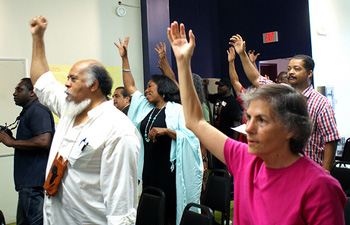 Rosalie Peterson of the Department of Neighborhood Empowerment raises her fist in the Community Issues Forum’s introductory Harambee chant. Rosalie Peterson of the Department of Neighborhood Empowerment raises her fist in the Community Issues Forum’s introductory Harambee chant. |
Moderators Carlos Montes and Dr Maulana Karenga each spoke about the history of black and Latino unity in the Americas before discussion of present community issues began. Montes, whose Chicano-Latino activism began with the Brown Berets in the 1960s, harkened to black-brown coalitions in the unified Third World fighting U.S. imperialism during the Cold War. “When we were attacked, we supported each other,” he said.
 Moderators Carlos Montes and Maulana Karenga analyze a participant’s comment before responding to his question. Moderators Carlos Montes and Maulana Karenga analyze a participant’s comment before responding to his question. |
Much of the morning’s rhetoric reflected its organizers’ backgrounds in radical and even militant activism. Karenga, chair of the African Studies department at California State University, Long Beach and creator of the pan-African holiday Kwanzaa, headed a black nationalist group that competed with the Black Panthers in the 1960s. That group, The Organization Us, maintains an office near Leimert Park.
“We struggle like this because together we will win,” said Karenga. “We are soldiers on the battlefield for something better… and we must talk often and productively with one another.”
Two participants in the South L.A. Power Coalition’s forum greet each other with a handshake and an embrace.
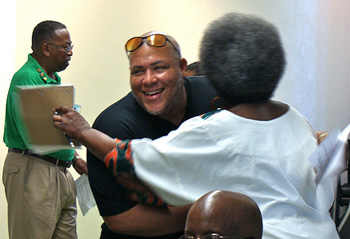 Two participants in the South L.A. Power Coalition’s forum greet each other with a handshake and an embrace. Two participants in the South L.A. Power Coalition’s forum greet each other with a handshake and an embrace. |
The community’s challenges
But cooperation is hardly as rosy as the facilitators described it in theory. Thandi Chimurenga, a freelance journalist, broached the black community’s concern that often Latino police officers, not just whites, commit violence against blacks.
Chimurenga called specifically on Latina women, addressing them as “mis hermanas,” to react to those killings in solidarity with their black neighbors.
“I need to hear a human cry from the community, and I need it to be translated into English and in Spanish. When a black person is murdered, I need to hear a human voice,” Chimurenga said. Scattered applause and encouraging murmurs followed.
In response, SLAPC member Blanca Cruz said Latinos who join the police force often become “rasa” – people who oppress their own people. “Cops… represent the oppressive system,” she said, no matter what ethnicity they claim.
Karenga hypothesized that the police department plays on historical neighborhood rivalry and uses Latinos against blacks. If so, “this is a battle strategy conversation. They’re trying to destroy our unity,” he said. “We must not let our oppressor” – that is, traditional white centers of power – “be our teacher about who we like, who we trust, or who we let across the border,” he said.
Also, reminded Montes, many in the Latino community have denounced Sheriff Lee Baca.
Another pertinent comment touched on the South Central Neighborhood’s Council recent resolution against the disproportionate rate of black student suspensions at Santee Educational Complex. Just 5 percent of Santee’s students are black, but 23 percent of them were suspended in 2011-2012, CityWatch LA reported (http://www.citywatchla.com/lead-stories/3751-blacks-and-latinos-unite-to-fight-for-reduction-in-black-student-suspensions).
Ron Gochez, a history teacher at Santee and vice president of the SCNC, addressed the problem as one of black-brown unity: rather than allowing the majority group (Latinos) to dominate the minority (blacks), both must come to a place of cultural understanding.
As a long-term remedy, Gochez proposed institutionalized ethnic studies programs in L.A. schools. Educating black and Latino students about their shared history, particularly during civil rights and labor movements, could help reduce inter-group violence and animosity.
“We need a vigorous multiculturalism, and I don’t mean food, fashion or festival,” Karenga said. “We share responsibility. We must practice reciprocal solidarity.”
Finally, thinly veiled calls to political action bubbled under the forum’s ideological surface. Two City Council candidates and a City Controller candidate addressed the crowd. But March’s election will be the first decided by new council district lines.
Black councilmembers have represented District 9, which encompasses much of South Central L.A., since 1963.
Gochez, who is running for the seat, encouraged residents to choose the person who could best represent both black and Latino residents.
Jitahidi also stressed unity in his closing remarks. District 9 cannot belong to a distinct group, he said.
“We’re not trying to be the best Democrats or the best Republicans or the best decline-to-state voters. We’re trying to kill the status quo” by continuing to elect “brave and courageous leaders,” Jitahidi said.
The SLAPC has not yet declared support for any candidate in L.A.’s March elections.
“Next time, we’ll need more time”
Long before polls open, however, the forum’s attendees must start working, Jitahidi said in his closing remarks. SLAPC officers cut off the line of attendees waiting to speak after more than 80 minutes of questions and suggestions. Still, only about a third of the forum’s participants addressed the crowd.
One of its final speakers requested monthly meetings. The crowd replied with fervent nods and a few supportive whistles.
Arnetta Mack, another organizer of the conference, affirmed these plans. “It was good for a first attempt,” she said. “Next time, we’ll need more time and more space.”
One Afro-Latina member of Karenga’s Organization Us, Hasani Soto, expressed the importance of educating community members in conversations like these. In identifying with both cultures, Hasani said she shares both groups’ knowledge and responsibilities.
“We need to study more, and not just TV or radio. We need to read more,” Soto said. “If we don’t do the studying and we don’t have the dialogue, the issues will still be there.”
Still, though, Soto was delighted by Saturday’s attempt. “It was excellent. It was beautiful,” she said.
However, Kahllid A. Al-Alim of the Park Mesa Heights Neighborhood Council warned that, to be effected, the forum needed to maintain organization.
With so many nonprofits and political activist organizations working on such a variance of issues, “This could be a case of too many cooks in the kitchen,” Al-Alim said.
Review of “Rome at the End of the Line”
By Sarah Fisch
When I heard that in “Rome at the End of the Line,” a contemporary Mexican play in which there are only two actors and each actress portrays each character between the ages of 7 and 80, I was highly dubious. This presents a quandary for both performers and audience; the actors must render a whole world within the confines of one stage, in the space of an evening. As for the viewers, we have to leave aside our expectations and engage wholeheartedly or not at all.
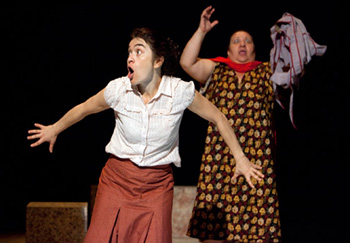 Julieta Ortiz and Norma Angelica in “Rome at the End of the Line.” Photo by Andrea Lopez. Julieta Ortiz and Norma Angelica in “Rome at the End of the Line.” Photo by Andrea Lopez. |
Last Saturday night was the first time this work, written by Daniel Serrano and and directed by Alberto Lomnitz, appeared anywhere in the U.S. In this portrait of a friendship between two women in Mexico, Evangelina and Emilia hang out on the train tracks, sharing dreams of an imaginary Rome. As little girls, as teenagers, as married women, and up until they are old ladies, they joke around, bicker and prepare a wild escape to Rome. It is a dangerous mission and an unlikely one, but they mean to flee their parents, their boyfriends (and later, marital) issues, and the confining identity their small town have bestowed on them.
We do not learn specifically where the girls live, and it doesn’t much matter except that it’s far-flung from cultural centers. To the girls, “Rome” means a kind of Mecca of the Mexican soul. Rome refers to the ancient city, but more importantly it symbolizes freedom, escape, hope and the girlhood ambitions that the two women share.
Rome sometimes reminds me of “Waiting for Godot:” Whether the girls succeed in reaching “Roma” is up to you. Meanwhile, the journey is full of surprisingly earthy discussions on sexuality, which brought the teenagers sitting behind me to gales of laughter.
In less expert hands of artists of Norma Angelica and Julieta Ortiz, this proposition would have been a disaster. It’s good luck that these women steer the performance with brilliant clarity, deep respect for women, and with hearts as large as any city in the world. The audience on Saturday night embraced the show completely, and for good reason.
This performance is suitable for those twelve years of age and older. It would be a great experience for mothers, daughters and granddaughters.
Go see ROMA AL FINAL DE LA VIA / ROME AT THE END OF THE LINE, Presentada en Español con subtítulos / presented in Spanish with English subtitles.
Cuando supe que en la obra mexicana Roma al Final de la Vía hay solamente dos actrices y que ambas escenifican a sus personajes desde su infancia hasta la vejez me preocupé mucho. Para un artista, hacer esto es muy complicado pues debe interpretar una vida entera entre las dimensiones del escenario. Para el público, observar una obra de este tipo también presenta un desafío pues debemos liberarnos de la prisión de las expectativas y entrar de lleno en el experimento.
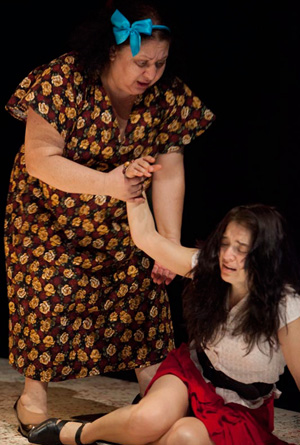
Norma Angelica and Julieta Ortiz in “Rome at the End of the Line.” Photo by Andrea Lopez.
El sábado pasado, esta obra escrita por Daniel Serrano y dirigida por Alberto Lomnitz debutó en los Estados Unidos. El montaje aborda la historia de Emilia y Evangelina, dos mujeres mexicanas cuya ilusión es viajar a Roma en el tren que pasa por las orillas de su pueblo. Primero como niñas, luego como mujeres y finalmente como viejitas, estas amigas hacen bromas, argumentan mucho, y preparan una fuga a — claro, Roma. Es una misión peligrosa (y poco probable), pero quieren arrancar de sus padres, de los problemas del amor joven (y después, del matrimonio), y del tipo de vida que se vive en un pueblo pequeño. No sabemos dónde específicamente viven las chicas, pero realmente no importa. Lo significativo es que viven en un lugar bien alejado de los centros culturales. Para las mujeres,”Roma” significa un tipo de meca del alma mexicana. La palabra se refiere a la ciudad, pero lo más importante es la idea de la libertad, la huida, la esperanza y la ambición de infancia que comparten estas dos mujeres. Roma a veces me recuerda a “Esperando a Godot”: Si la mujeres llegaron o no a Roma depende de la interpretación del observador. Lo cierto, es que este viaje está lleno de debates sorprendentemente honestos sobre la sexualidad, lo que hizo a las dos muchachas sentadas detrás de mí reír a carcajadas.
En las manos de artistas menos peritos que Norma Angélica y Julieta Ortiz, esta proposición hubiera sido un desastre. Estas mujeres actúan con una claridad brillante, con un respeto profundo hacia el corazón de las mujeres, y con unas ganas gigantescas. El público realmente disfruto el espectáculo.
Este obra es adecuada para personas mayores de doce años. Es una gran experiencia para madres, hijas y nietas. Vayan a verla.
Hasta el 7 de Octubre / Through October 7 at The 24th Street Theatre
1117 West 24th Street
(213) 745-6516
www.24thstreet.org
Healthy food walk around USC unearths tensions between the University and the community
{article_content}
South LA small businesses looking for missing details in USC expansion plan
With a final vote postponed until late November, The University of Southern California has a few more months to provide more details in its quest to get City approval for extensive development and renovations both on campus and on properties nearby.
Community interest has been intensely focused on University Village, a shopping development just across Jefferson Boulevard from the main campus. Opposition to the development has mostly centered on concerns about student housing to be built there. But small businesses in the area are worried about their place in the new development.
Local small businesses wonder if and how they’ll be included
The need for improvement to University Village (UV) is not in dispute. The current buildings are tatty-looking and in need of modernization and upgrades. The proposed new development will contain retail space, including a full-service grocery store, academic and administrative space, convention space, and more student housing.
Most of the businesses currently operating in UV are small, locally-owned and -operated shops, including a bicycle shop, a shoe-repair shop, an optometrist, a cigar shop, nail salons, a hair salon, and a food court populated with miniature mom-&-pop restaurants. There is also a small multi-screen discount movie theater, a discount grocery, a 99-cent store, and the lone big-box retailer, Starbucks.
The merchants running the local shops have been asking, during the mutli-year process of developing the plan, for more details on a range of issues: when they are expected to move out, what kind of help they will receive for relocation during the projected two-year demolition and construction process, and if and how they will be allowed back in. They have been given a move-out target of August 2013, but that’s the most detail they say they have received.
USC has promised relocation help, but no details have been provided in the Development Agreement so far. Nor have the merchants been told what criteria will be used to decide who will be allowed back in after construction.
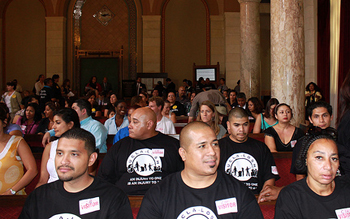 Packed aisles at Los Angeles City PLUM Meeting August 21. A vote approving or denying USC’s Specific Plan for University Village was postponed to November. Packed aisles at Los Angeles City PLUM Meeting August 21. A vote approving or denying USC’s Specific Plan for University Village was postponed to November. |
Addressing Los Angeles City Council’s PLUM (Planning and Land Use Management) commissioners at a packed August hearing, local businessman Jorge Nuno stated during public comments that the community benefit package, which will be part of the Development Agreement, doesn’t put enough emphasis on resources to help small businesses.
Nuno, who owns The NTS Group, a small advertising and marketing firm located on East 35th Street, has been studying the issue over the last couple of years. In a follow-up interview, he said he “sees a lot of challenges in the area: small businesses need to have access to the development. They need educational resources for business plans.”
USC offers free basic legal help to local small businesses
In official documents and public statements, USC points to two clinics specifically aimed at helping local small businesses. One, the Small Business Clinic, administered through the Gould School of Law, provides help with basic start-up legal paperwork to local small businesses. The Business Clinic’s services, free except for filing costs, include structuring businesses -– as corporations, limited liability partnerships, or sole proprietorships and the like. The clinic also helps draft basic contracts with vendors and clients of the participating business.
Faculty advisor Michael Chasalow said the clinic keeps the paperwork as simple as possible. “Our demographic is not fancy folk. It’s primarily salt-of-the-earth,” mom-and-pop businesses that provide services to the community. “They don’t want or need something complicated,” said Chasalow.
The purpose of the student-staffed clinic is educational -– to teach students how to craft the best service for customers, but “the benefits go to the community,” said Chasalow. In the five years the clinic has been open, it’s served almost 300 clients and currently has a waiting list. When clients need more than the SBC offers, they are referred to area non-profits like SCORE, Public Counsel, and the Pacific Asian Consortium in Employment (PACE), or the local Chamber of Commerce.
“What we offer,” said Chasalow, “is very different than the kind of advice you’d get if you went to a firm,” which would charge high fees. “If you’re trying to start a business on five-thousand dollars, an eight- hundred dollar fee is a lot.”
USC’s free business consulting clinic
USC also offers a free business consulting clinic, Los Angeles Community Impact (LACI), through the Marshall School of Business. Also student-run, LACI helps local entrepreneurs create business and marketing plans that will help them sustain and grow their businesses.
According to Neil Garvey, a junior and LACI’s vice-president for external affairs, most of the clinic’s clients need help focusing their goals. “You don’t have time to think about where your business is going if you’re just busy running the business,” but he said, “a business plan isn’t as complicated as people expect it to be.”
LACI president Jeremy Gross, also a junior, concurred, saying, “Many are spread too thin. They say yes to all their clients’ requests,” but with doing “payroll, managing staff and clients, paying the bills,” it’s aquestion of limited time and resources. “Many clients just have too many ideas. We help them winnow that.”
LACI assigns clients a team of four to five students. Over the course of a process that can stretch to up to twelve weeks, team members help clients refine their goals. The team carries out studies and surveys assessing local awareness of and interest in the client’s services, identifies possible competition, and then delivers a set of succinct recommendations and “next-steps” that clients can carry out on their own. The team then conducts a follow-up a month or so later to see how things are working out.
Is the community aware of these services?
Nuno said some small business owners he talked to confirmed USC has reached out to make them aware of these programs. But, he said, “many say they feel intimidated, because USC is talking big numbers, but they’re small businesses.”
That statement may seem a bit odd, given the fact that both clinics tailor their free services for mom-and-pops, but, said Chasalow, “with law in particular, you see people who feel they lack sophistication and may be intimidated from the get-go.”
Garvey and Gross, of LACI, feel that the sheer size of USC might lead to a perception that its programs are too hard to access. For instance, said Garvey, if you’re trying to become a vendor to the University, “the bureaucracy and red tape” of dealing with the university “is very frustrating,” even though USC has a local vendor initiative.
Gross added, “A lot of the businesses around USC don’t have a deep relationship with USC, but often want one. It’s almost like a lone market within a larger market. it’s very difficult for a mom-and-pop to get through the red tape. How do you even find out who to call?”
Said Garvey, “I think that speaks to the larger issue that USC students are a completely different market than the surrounding area. And businesses serve either one or the other, but usually not both.” That town-and-gown division might contribute to the idea that even services aimed at local small business, like the clinics, are intimidatingly inaccessible.
Loans to help local business
Some of what Nuno says is missing from USC’s current draft Development Agreement does involve larger numbers. He’d like to see “a revolving loan fund to help with relocation and business expansion…. USC could really do something big with a small amount of money,” says Nuno.
He says one to two million dollars would be ample to provide revolving loans to up to forty small local businesses.
Final city vote postponed until late November
It would be erroneous to say that the community is universally against the development. There is significant community support for the proposed improvements to shopping choices, aesthetics, and even the increased public safety that is expected as a result of the rebuilding.
But small businesses are hoping missing details will be provided in time. The current draft Development Agreement does not as yet provide them. And that’s important, because the Final Development Agreement with the City will be a legally binding document. With the final vote postponed until late November, there is still time for those details to be fleshed out. But not much time.
History comes to life at the Angelus Rosedale Cemetery
Marilyn Monroe’s Grandmother, Buster Keaton’s Cameraman Join Vaudeville and Jazz Age Performers on this Unique Outdoor “Stage”
Flappers, singers, dancers, magicians, and even a celebrity chef – a host of colorful entertainers rest at Angelus Rosedale Cemetery, one of the city’s oldest, most historically significant cemeteries.
On Saturday, September 29, at the 22nd annual Living History Tour, visitors will “meet” some of Los Angeles’s most interesting early performers and entertainment industry personages as costumed actors, at graveside, portray the lives of a Civil War-era escape artist, a headlining dancer who lost her life in the 1933 Long Beach earthquake, a mezzo soprano who fought for civil rights, and a Chinese-American dancer/actor/MC, among other quirky and wonderful characters. Tours depart every 25 minutes from 9:00 a.m. to 12:00 noon. Advance reservations are required.
This year’s tour commemorates not only Los Angeles’s longtime role as the center of this country’s entertainment industry, but also the roles several of these personages played in the larger history of civil rights. In addition, the tour memorializes the 150th anniversary of the Civil War (1861-1865).
This year’s portrayals include:
• Della Hogan Monroe, Marilyn Monroe’s colorful grandmother; a religious devotee, Mrs. Monroe had baby Norma Jean baptized at the Hawthorne Foursquare Church in 1926;
• Victor Dol, L.A.’s first chef trained in Paris, who opened an elegant French restaurant in 1876 that soon earned the nickname “Delmonico’s of the West”;
• Rita Carewe, a Jazz Age starlet and “Baby WAMPAS” (Western Association of Motion Picture Advertisers) winner who appeared in films with Delores del Rio, Edward Everett Horton, and Mary Pickford;
• Sadie Cole, a Fisk Jubilee singer and a civil rights activist who helped desegregate L.A.’s cafes and beaches;
• Byron Houck, baseball pitcher for the 1913 World Series Philadelphia A’s, who later became Buster Keaton’s cameraman on “The General.” Houck was the Vernon Tigers’ ace pitcher when the team was owned by Roscoe “Fatty” Arbuckle;
• Mildred Washington, a vaudeville dancer and choreographer who headlined at Sebastian’s Cotton Club in Los Angeles;
• Harry Cooke, Magician and Civil War Union Army “scout” who was America’s first Escape Artist;
• Honorable Wu (Harry Gee Haw), actor, singer, dancer, and vaudeville impresario known as “The Broadway Mandarin.”
Angelus Rosedale Cemetery was founded in 1884, and is now home to many generations of Los Angeles’s citizens, representing every race, faith, and creed. Each year, West Adams Heritage Association (WAHA) tells some of their life stories while touring the historic grounds and elaborately carved monuments of L.A.’s first lawn cemetery.
TICKET SALES/TOUR TIMES
Advance Ticket Sales Only—No Walk-ins! $25 in advance, paid by September 24. $35 after that or on day of tour, space permitting. (Children under 10 attend free.)
Tours depart approximately every 25 minutes, beginning at 9 a.m., with the last tour at noon. The public is invited. Tickets are by ADVANCE RESERVATION ONLY; each tour has a limited number of spaces. The Living History Tour is a three-hour docent-led walk through the cemetery, over uneven terrain; visitors are advised to wear appropriate clothing and walking shoes.
Address: 1831 West Washington Blvd., Los Angeles, CA 90007.
For tickets and information, log onto www.WestAdamsHeritage.org. 323-732-4223 or tours[at]westadamsheritage.org.
The tour will raise funds for the West Adams Heritage Association, a nonprofit organization that was founded in 1983 to support preservation of the community’s architectural and cultural heritage. WAHA has grown from a small resident support group to a recognized preservation voice with hundreds of members who live in the many neighborhoods of the Historic West Adams District.
Opinion: Many Dorsey High School members united to stop reconstitution
By Taylor Broom (Dorsey Alumni class of 2011, Community Organizer with Coalition for Educational Justice—CEJ), Sharonne Hapuarachy (Dorsey Teacher and English Dept. Chair), Hilda Daily (Dorsey parent) and Noah Lippe-Klein (Dorsey teacher and UTLA Chapter Chair)
Last Spring, Superintendent Deasy rejected Dorsey High School’s PSC (Public School Choice) plan and said if our upcoming re-write was not to his liking, then he would reconstitute Dorsey.
Upon hearing this, parents and alumni started meeting weekly to discuss a two-pronged approach to prevent reconstitution: (1) learn how students and community have been impacted by reconstitutions at other schools, and (2) unite a broad coalition of Dorsey community, Crenshaw community and the people throughout South LA, around the idea that reconstituting a school with such a committed faculty and strong programs would hurt students.
 Taylor Broom, a co-author of this story and a Dorsey High School alum. Taylor Broom, a co-author of this story and a Dorsey High School alum. |
So, what is the Dorsey community doing to fight back?
• Dorsey parents and students have been speaking at School Board meetings to tell Deasy and the LAUSD Board members all the reasons that reconstitution would harm the school. (See videos of these powerful presentations and “like” us at facebook.com/DorseyDonsFightingReconstitution .)
• Dorsey parents, alumni and teachers hosted a workshop at a major South LA conference this summer to raise awareness about reconstitution among community members and elected officials.
• Dorsey and Crenshaw teachers and alumni began working with a group of respected black community leaders and organizations in South LA (Ma’at Institute for Community Change, African American Cultural Center, CEJ) who have been advocating to improve schools. This coalition is prioritizing fighting institutionally racist policies in LAUSD, like the disproportionate suspension rates of black students, preventing reconstitution, AND supporting the struggles around Dorsey and Crenshaw school improvement.
• Dorsey stakeholders are in dialogue with Crenshaw teachers and community members and the entire Dorsey/Crenshaw feeder system. We see our struggle as one and the same because over the summer Crenshaw had to push back against Deasy’s threats to end its nationally recognized extended learning school reform model. Both schools are working closely with the community to prevent reconstitution and implement a plan rooted in culturally relevant, research-based strategies to meet the needs of our students.
• Dorsey’s staff and community are working closely with our principal to write a high-quality plan. Implementing a reform plan that works for Dorsey’s students is a key priority.
NOW DORSEY NEEDS YOUR SUPPORT: On September 27, Dorsey’s parents, alumni, community and students are planning a major community event with the theme of “Celebrating, Improving and Fighting for Dorsey.”
The event will celebrate Dorsey’s:
• teachers and faculty who have impacted lives
• programs that serve students
• role in the community
Celebrating Dorsey’s strengths is a way of saying, “Our school should not be reconstituted.”
Why is it so critical to prevent the reconstitution of Dorsey?
If sponsoring teachers lost their positions, key programs (like the Dorsey Ivy League College Preparation program, the prestigious Culinary Arts program, the rising Academic Decathlon team, the Annual Student Film Festival, the nationally recognized Theater Department, the 20thCentury Fox Partnership, and so much more) would be lost. Other reconstituted schools have already experienced this hemorrhaging and Dorsey would be at risk for this as well.
We also worry about the loss of faculty who support the disproportionately high number of Dorsey students in foster care and group homes. Many of these students rely on their teachers and counselors to provide stability in their lives.
Reconstitution would bring a newer faculty with less understanding of how to build upon some of Dorsey’s strengths:
• The number of committed teacher-alumni and teachers living in the community. Often, teachers with strong ties to community are pushed out of a reconstituted school.
• Strong ties that Dorsey has with black institutions in the community who support Dorsey’s students, the connections with historically black colleges and the growing number of ivy league schools that recruit Dorsey’s students.
• The gains made by the growing number of English Language Learner students—Dorsey has made huge strides in re-designating these students through focused support.
Are we merely trying to stop reconstitution? No, we are serious about improvements at Dorsey too — for example, improvements in pedagogy, personalization, community ties, internships, and the career and college readiness of students.
This fight won’t be won on Sept 27th, but if you care about Dorsey, the Dorsey/Crenshaw community, South LA, and public education in general, then mark your calendars and attend this critical event.
Location: 100 feet from Dorsey’s campus at the Rancho Cienega Gym. 5001 Rodeo, Los Angeles. at 5:30 pm Click here for a map of the location.















